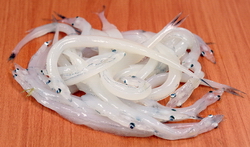
Food Safety Focus (42nd Issue, January 2010) – Incident in Focus
Formaldehyde in Noodlefish
Reported by Ms. Janny MA, Scientific Officer,
Risk Assessment Section, Centre for Food Safety
The Centre for Food Safety (CFS) has recently released the results of targeted food surveillance on noodlefish. Results showed that a noodlefish sample was found to contain formaldehyde, a non-permitted preservative, at 1200 mg/kg. This article provides food safety information on formaldehyde in food especially noodlefish.
Fresh noodlefish photo

What is Formaldehyde?
Formaldehyde, also known as methanal, is a colourless gas but with a pungent and irritating smell. It is highly reactive and readily soluble in water. Pure formaldehyde is not commercially available while formalin (about 37% formaldehyde) is the most common formaldehyde-containing solution. Formaldehyde is generally used in industry for the production of plastic resins. It can also be used in a variety of products such as fertilisers, preservatives, disinfectants, cosmetics, fungicides and textiles.
Formaldehyde is ubiquitous in the environment. Its presence is either produced from natural or manmade sources. Formaldehyde occurs naturally in the environment through various processes such as forest fires. It also exists at low levels in many living organisms as a metabolic intermediate. The manmade sources of formaldehyde include combustions (e.g., vehicle emissions, wood burning, power plant and waste incineration), building materials and tobacco smoke.
Inhalation, especially indoor air, is the major exposure route of formaldehyde among the general population. People may also be exposed to formaldehyde from other sources such as cosmetics and food. Even though it is difficult to estimate the daily intake of formaldehyde from food, the World Health Organization (WHO) estimated it may range between 1.5 and 14 mg in average adult. Other oversea report suggested that if the major contribution is from food, an adult may be exposed up to about 10.55 mg formaldehyde per day.
Formaldehyde in Food
Naturally Occurring
Formaldehyde is present in many animal and plant species as a product of their normal metabolism. Formaldehyde can be found naturally in food including fruits, vegetables, meats, marine fish and crustacean, with levels up to 300 to 400 mg/kg. However, there is no report that formaldehyde is naturally present in noodlefish. Study conducted by the CFS suggested that formaldehyde found in noodlefish was a result of abuse.
For more information on naturally occurring formaldehyde, please refer to "Formaldehyde in Food" in the Food Safety Focus (6th Issue, January 2007).
Illegal Use as Food Additive
Formaldehyde is used as a food preservative illegally since it can prolong the shelf-life of a food by protecting against deterioration caused by microorganisms.
High level of formaldehyde (1200 mg/kg) detected in the concerned noodlefish is likely to be added deliberately as a preservative after the fish was caught, during transportation or storage.
The texture of noodlefish adulterated with formaldehyde is likely to be stiff since formaldehyde would react with the fish protein and result in muscle toughness and reduce its palatability.
Health Effects of Formaldehyde
Ingestion of a small amount of formaldehyde is not likely to cause any acute effect; however, the intake of formaldehyde in a large amount can cause severe abdominal pain, vomiting, coma, renal injury and possible death in humans. Prolonged ingestion of formaldehyde in drinking-water caused stomach irritation in experimental animals.
The cancer-causing property is the main health concern of formaldehyde. In 2004, the International Agency for Research on Cancer of the WHO classified formaldehyde as "carcinogenic to humans" (Group 1), with consideration that there is sufficient evidence indicating formaldehyde causes nasopharyngeal cancer in humans through occupational exposure. However, in view of the available evidence, WHO considered formaldehyde is not cancer-causing upon ingestion.
Safety Reference Value
The U.S. Environmental Protection Agency has established a chronic oral reference dose of 0.2 mg/kg bw/day for formaldehyde. Adverse health effects due to prolonged consumption of the concerned noodlefish with formaldehyde at 1200 mg/kg cannot be ruled out.
|
Key Points to Note
|
Local Situation
In Hong Kong, under the Preservatives in Food Regulation, formaldehyde is not a permitted preservative in food.
Over the past years, the CFS has been monitoring the illegal use of formaldehyde in noodlefish. In 2007-2009, a total of 46 noodlefish samples were collected, in which 18 (39%) were found to have used formaldehyde illegally. Improvements were shown last year with the unsatisfactory rate declined from 50% in 2007 to 8% in 2009.
Advice to Public
- Patronise reliable food premises and food retailers.
- Choose only fish that are fresh and avoid those with unusual smell and noodlefish that are stiff.
- Wash noodlefish thoroughly before cooking as formaldehyde is water-soluble.
- Take a balanced diet so as to avoid excessive intake of food chemicals from a small range of food items.
Advice to Trade
- Carefully check the origins of food products, and only obtain them from reliable sources.
- Do not add formaldehyde in food. Store noodlefish at low temperatures, preferably at frozen condition, to minimise spoilage.
- Maintain a proper cold chain to ensure that fish and fish products are kept safely throughout processes including storage, transportation and display for sale.
Further information
The CFS Risk in Brief on "Formaldehyde in Food".

